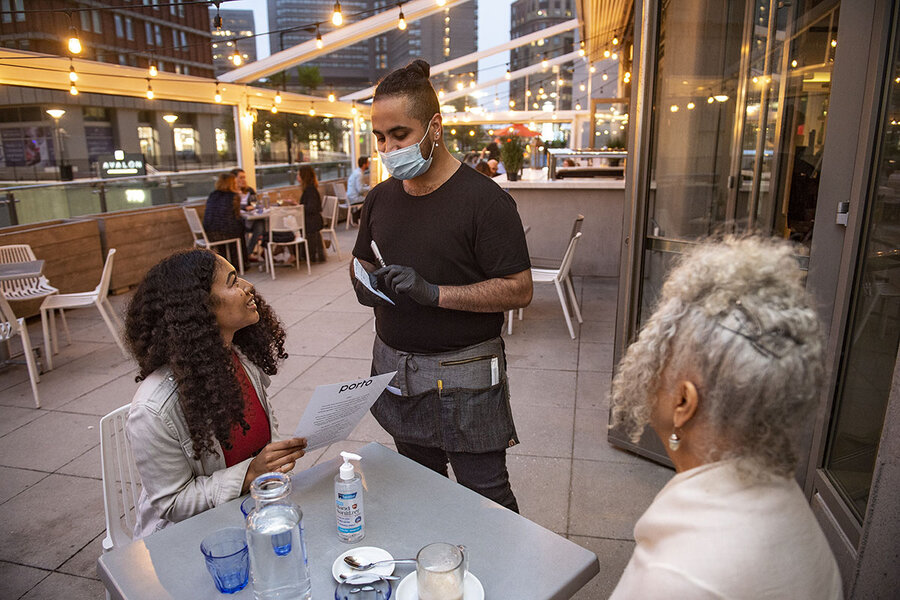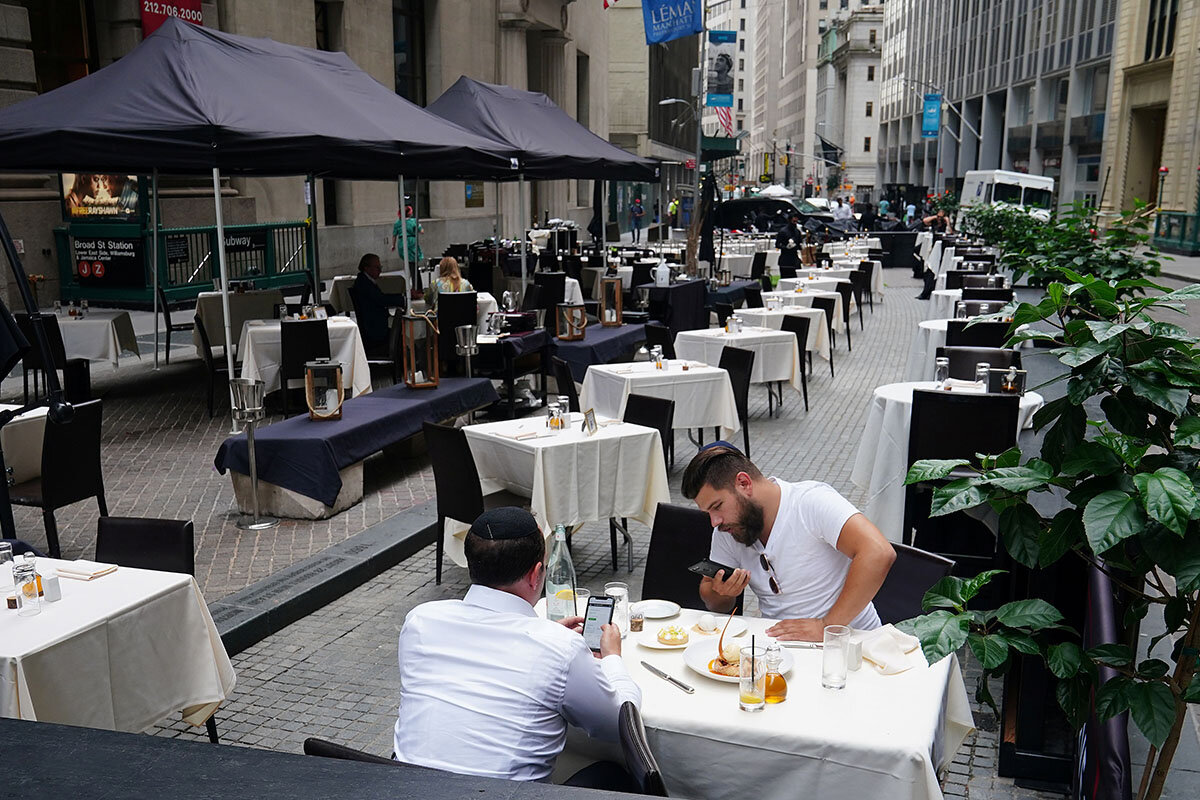Heat lamps and hot cider. Can restaurants survive a pandemic winter?
Loading...
Guido Oppizzi hoped that State Street, the main thoroughfare in his adopted hometown of Santa Barbara, California, and home to his popular bistro, could someday become a pedestrian promenade reminiscent of the cafe-packed piazzas in his native Italy.
“Then the pandemic hit,” he says. “It wasn’t the way anyone would have wanted it to happen, but the city decided in May to close State Street – and that actually saved my restaurant.”
Outdoor seating at Oppi’z expanded from seating for four to 50 thanks to alfresco dining on State Street, which is now oozing with the European-style ambiance Mr. Oppizzi had dreamed of.
Why We Wrote This
Outdoor dining and street closures have buoyed the embattled restaurant industry. But as winter threatens the alfresco appeal, restaurants are hopeful that ingenuity, federal aid, and community support will help them survive.
All over the United States – in other small cities like Boulder, Colorado; and Portland, Maine; to mega metropolises such as San Francisco, Chicago, Las Vegas, Miami, and New York – streets have been closed, sidewalks opened, and parking spaces converted into “parklets” to create outdoor dining opportunities amid pandemic restrictions.
Even if restaurants in some cities have opened indoors, capacity is limited, and diners wary of indoor spaces often opt instead for takeout, which by itself cannot keep restaurants afloat.
The nod to alfresco dining has provided critical relief to the restaurant industry, which has been especially hard hit by COVID-19.
A National Restaurant Association survey recently found that 1 in 6 restaurants in the U.S. have shuttered during the pandemic and 40% of those still open say that, without federal relief, they are likely to close within six months. The organization forecasts that restaurants will lose $240 billion this year.
Thousands of chefs and restaurant owners have formed a trade group, the Independent Restaurant Coalition, and are calling for a $120 billion grant to help them keep their stoves lit through 2020.
But with the change of seasons, an air of uncertainty now looms. Winter is coming, and for many in the restaurant industry, it brings a deeper chill.
In Portland, Maine, where several downtown streets have closed to traffic since June 1, restaurateurs are glad for the stretch of dry, sun-drenched summer days that filled their plein-air tables and boosted bottom lines. But as autumn’s chill moves in, they are looking ahead.
“We can’t afford not to,” says Arryan Decatur, general manager of the East Ender, a New American bistro.
He and East Ender owner Karl Deuben, along with their neighbors, are petitioning the city to extend the Nov. 1 deadline for reopening the street. He’s also busy trying out heat lamps, curating new dishes for the takeout menu, and researching ventilation systems for when they open their cozy, two-story restaurant.
No one can afford to sit idle. Others are also pleading with city leaders for more time outdoors, and investing in tents, sophisticated air-filtration systems, and propane heat lamps.
Indeed, among the enormous challenges facing restaurateurs this year is the need to balance hospitality with new safety protocols and also to plan for seasonal changes. Even in an outdoor setting, many health authorities advise that restaurants follow social distancing, staff wear masks (and diners wear them when not seated), and cleanliness and sanitation remain on the front burner.
“We have been as eager to create a fun experience as we have been careful in our planning,” says Mr. Decatur.
“Grateful to my community”
For many restaurants, local communities have been a boon.
In Boston’s South End, where streets are heavily traveled and not easily closed to traffic, some restaurants got a boost from grassroots efforts.
At Frenchie, for example, owner Sandrine Rossi tried unsuccessfully for months to obtain a permit for outdoor seating. Eventually, patrons in her neighborhood joined with the South End Business Alliance to clinch permits for four parking spaces in front of the French bistro, quadrupling seating from about eight to 30.
“I am so grateful to my community,” says Ms. Rossi. “When the lockdown happened, I got really scared and thought I wouldn’t make it, but today we’re in good shape. It’s such a blessing.”
Ms. Rossi and her husband are both from the south of France and would love to visit family there soon, but they don’t feel they can leave just yet. With the change in seasons and the deadline approaching for reopening those parking spaces, she’s bracing for what’s next.
“We can’t predict people’s behavior,” she says. “We will have to continue to rely on our incredibly supportive community to stay alive.”
Grassroots efforts also helped buoy 11 restaurants in the predominantly Black neighborhood of Chatham on Chicago’s South Side thanks to the 75th Street Boardwalk Project, an initiative to transform this neighborhood into an attractive outdoor dining area.
Using $250,000 raised by the city and donors, local artists and community youth transformed plywood once used to board up restaurants during Black Lives Matter protests into material for lime-green parklets, which provide space for dining and children’s play areas.
Brown Sugar Bakery is one of the neighborhood’s businesses that has benefited from the expanded seating and pretty, eye-catching spaces. Co-owner Zoie Reams speaks glowingly of the project not just for its boost to her award-winning bakery, but also for the neighborhood.
“I love that the wood is being used for something so positive and exciting,” she says. “It’s transformed our community. People don’t always think about how a community looks. It can look desolate, but changes like these – lime-green paint, plants, games for kids – can really change one’s mindset.”
“A happy-ish ending”
Perhaps no city has been more dramatically changed by pedestrianized streets than New York, where some 10,000 restaurants have opened outdoor dining on 87 streets and nine pedestrian plazas. Many streets are only car-free for alfresco dining from Friday afternoons to Sunday nights, but the initiative has been a boon to restaurants and a much-needed morale boost for residents.
“New York has done this so well,” says Mike Lydon, founder of the urban planning organization Street Plans. “It’s not easy in this huge city to get permission to do anything, but the city quickly realized it could not process and oversee every application, so it provided safety criteria that restaurants had to meet and then let them self-certify. Permits could then be issued in just a couple of days.”
The initiative, he says, has boosted restaurants, as well as access to public spaces, a sense of community, and basic livability.
“New York was brutalized by the pandemic in March, and there was still a lot of trauma in May,” he says. “But New York being New York, the city has a strong sense of identity and a spirit that we’re here for the collective good, so people have been sticking to the program, wearing masks on the subway and all.”
Mr. Lydon is optimistic that when restaurants can open indoors at 25% capacity on Sept. 30, as was recently announced, it will help business when the temperatures turn nippy.
“Everyone knows, though, that won’t be enough,” he says, adding that he’s game to follow the lead of Nordic countries and dine outside in January if he can sit beside a heat lamp wrapped in a blanket.
This will now be an option, as the city recently announced that outdoor dining, originally scheduled to end Oct. 31, will be permitted year-round.
Fellow New Yorker Henry Rinehart, a former restaurant owner, also hopes diners will adopt this Scandinavian model to support restaurateurs. “In so-called normal times,” he explains, “restaurant folks are highly motivated, compliant, and careful guardians of public health, and this year, they’ve demonstrated those qualities even more than ever.”
“If we as consumers can treat food-service workers as our partners and do whatever we can to support them, even if it means bundling up,” he adds, “there’s a pretty good chance for a happy-ish ending.”
Editor’s note: As a public service, we have removed our paywall for all pandemic-related stories.






